November 19th
“No overtaking trucks while they are in the tunnel”. This sounds like good advice to me and was posted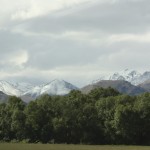 on a sign just outside of Kaikoura along a two-lane highway. This was a long day of mostly riding in the van. I’m including my notes to give a brief overview of the countryside we were passing through and a somewhat typical driving day.
on a sign just outside of Kaikoura along a two-lane highway. This was a long day of mostly riding in the van. I’m including my notes to give a brief overview of the countryside we were passing through and a somewhat typical driving day.
- Lots of trees, very few natives, according to Derek.
Hills were painted yellow with Scotch Broom—one of our many surprises was that Scotch Broom covered many hills, very pretty but I know in the Eugene area there is every effort to get rid of this invasive species.
A triangular sign said Alpine Pacific Triangle.
Kiwi Rail Train—a very small train.
Drove to St. Agnes Lagoon Wildlife Refuge looking for a goose
- No goose, just shags, coots, black swans.
Fields of black currents, which are used for juice and are harvested by machine.
Lovely green fields—divided by narrow, tall hedges of trees. Hay is in rolls. Grapes and wineries are frequent. In spite of the amount of time spent in the van on this day we saw a number of different kinds of birds.
We stopped to look at a large, enclosed herd of red deer.
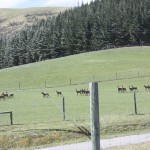 We saw many of these enclosures, just as one would fence cattle. The deer, which look like small elk, have to be handled at night because they are so skittish. Many restaurant menus list venison.
We saw many of these enclosures, just as one would fence cattle. The deer, which look like small elk, have to be handled at night because they are so skittish. Many restaurant menus list venison.
Signs: Terrace Edge Wine and Olive Oil, Pegasus Bay Winery. Here we were in the Waipara Valley wine district.
Around 11 a.m. we passed through the town of Amberley.
• A sign said : “Amberley, take your time”. Someone had scratched out part of it and it now read “take your pills”. And somewhere in the area was a sign that said “If at first you don’t succeed scuba diving isn’t for you”.
$245 for 175 litres of gas, if we wished to purchase that amount.
We stopped at the Ashley River Mouth Restoration site at Waikuku Beach.
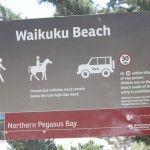 Walking along the beach took some effort as the wind was fierce. Several men, and one woman, were fishing for tiny fish (whitebait), using weirs. They can get paid$175 per kilogram. The fish spend three or four years in the ocean and then run back up the river. Fishermen build fishing shacks along the rivers and in 2006 one site sold for $46,000. www.cascadewhitebait.co.nz/history and www.teara.govt.nz/en/whitebait-and-whitebaiting/page-1 are both interesting websites. The latter also includes Moari history with these fish.
Walking along the beach took some effort as the wind was fierce. Several men, and one woman, were fishing for tiny fish (whitebait), using weirs. They can get paid$175 per kilogram. The fish spend three or four years in the ocean and then run back up the river. Fishermen build fishing shacks along the rivers and in 2006 one site sold for $46,000. www.cascadewhitebait.co.nz/history and www.teara.govt.nz/en/whitebait-and-whitebaiting/page-1 are both interesting websites. The latter also includes Moari history with these fish.- We saw a large number of godwits here.
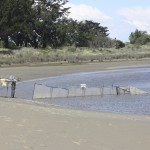
Weirs for whitebait
- When we stopped for lunch our shoes left sand blotches all over the floor.
We drove through Christchurch and by 2:30 were looking across very flat, green fields, some bright with yellow flowers and dotted with sheep, all backed by snowy mountains on the horizon, reminding me a bit of the Wallowa Mountains area in eastern Oregon.
- Dark gray clouds threatened and curtains of rain swept across with now and then a hint of rainbows. Then wet snow spattered briefly before the sun appeared again. We passed the Salmon World Building and a very tall image of a leaping salmon, at least 40 feet high. In Ashford snowflakes were again hitting the windshield. But then, once again, it became sunny and warm.
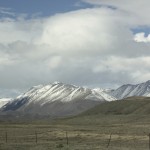 We passed a sign for Mt. Dobson Ski Area with an arrow pointing to the right. Lake Tekapo was our next stop , a very large, aquamarine reservoir that had been a natural lake left behind by retreating glaciers but now was dammed to raise the water level and use for hydropower.
We passed a sign for Mt. Dobson Ski Area with an arrow pointing to the right. Lake Tekapo was our next stop , a very large, aquamarine reservoir that had been a natural lake left behind by retreating glaciers but now was dammed to raise the water level and use for hydropower.
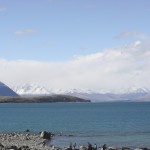
- New Zealand’s electricity is mainly produced from hydropower and geothermal power with wind energy use increasing. Seventy-five percent of energy production is from renewable resources although, according to one source, they are not as energy
efficient as might be expected. We stopped briefly to use the restrooms and take pictures. A little rock Church of the Good Shepherd, built in 1935, is perched at the lake’s edge. Nearby is a bronze statue of a collie, whose inscription said the area couldn’t have been settled without collies. Swarms of tourists were there snapping pictures of the scenery and each other. It was truly a beautiful, though chilly, setting.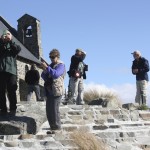
Our group at Church of the Good Shepherd
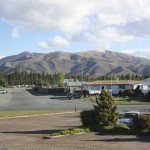 We would be at our next motel, a few miles from the lake, in the little town of Twizle, for three nights. Twizle has a population of about 1200 although this number is nearly tripled during tourist seasons. It was originally built as a place to for the men working on the hydropower projects to stay and some buildings, still being used, were meant to be torn down after the projects were completed. Today the town serves tourists and recreational users who come to ski, boat, hike, etc. The area also has some of the darkest, cleanest and driest skies in the world and draws astronomers as well as providing astro-tours. According to Wikipedia: “Since 2012 Twizle has been a part of the Aoraki Mackenzie International Dark-Sky Reserve, one of only five such reserves in the world recognized by the International Dark-Sky Association. “
We would be at our next motel, a few miles from the lake, in the little town of Twizle, for three nights. Twizle has a population of about 1200 although this number is nearly tripled during tourist seasons. It was originally built as a place to for the men working on the hydropower projects to stay and some buildings, still being used, were meant to be torn down after the projects were completed. Today the town serves tourists and recreational users who come to ski, boat, hike, etc. The area also has some of the darkest, cleanest and driest skies in the world and draws astronomers as well as providing astro-tours. According to Wikipedia: “Since 2012 Twizle has been a part of the Aoraki Mackenzie International Dark-Sky Reserve, one of only five such reserves in the world recognized by the International Dark-Sky Association. “
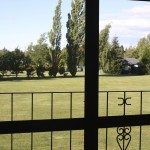
Motel balconey
But we weren’t here for dark skies, we were here for birds and I noticed fairly soon that we had starlings nesting in the downspout next to our balcony, the parents frequently coming and going. We were in room 120 with a view across a large lawn and, in the distance, snowy mountains. There were two queen-sized beds and a big heater was set into the wall. By now we were more than ready to go downstairs for dinner—
The next day our goal was Mt. Cook.

